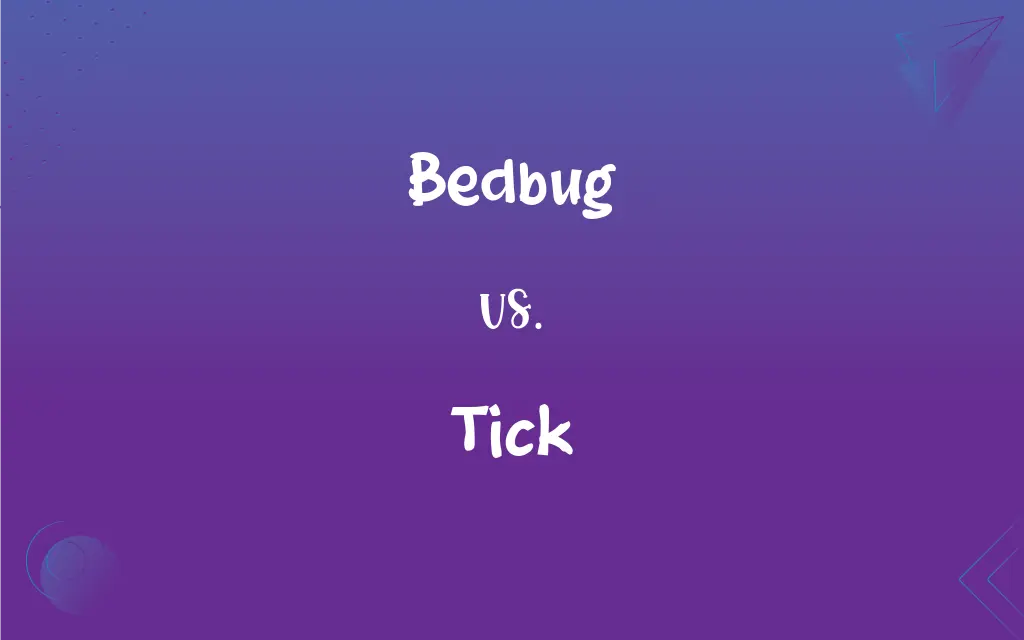Bedbug vs. Tick: What's the Difference?
Edited by Janet White || By Harlon Moss || Updated on October 27, 2023
Bedbugs are small insects feeding on human blood and often found in beds; ticks are arachnids that bite to feed on blood and can transmit diseases.

Key Differences
Bedbugs are insects belonging to the family Cimicidae. They are small, flat, and wingless, with their primary source of nourishment being human blood. These nocturnal pests are most active at night, often hiding in mattresses, bedding, and cracks in furniture during the day. In contrast, ticks are arachnids, relatives of spiders and mites. Ticks have eight legs and are well-known for attaching to their hosts to consume their blood.
Both bedbugs and ticks have biting habits, but their motivations differ slightly. Bedbugs bite to feed and usually do not transmit diseases to humans. Their bites can cause itching and discomfort, and their presence is often linked to poor sanitation or cleanliness. However, ticks, when they bite, can transmit various diseases, including Lyme disease and Rocky Mountain spotted fever. It's crucial to remove an attached tick promptly to reduce the risk of disease transmission.
A notable distinction between bedbugs and ticks lies in their preferred habitats. Bedbugs are primarily urban pests, thriving in environments close to humans, such as homes, hotels, and hostels. They don't live on their hosts but return to their hiding places after feeding. On the other hand, ticks are found in more natural settings like forests, grasslands, and brushy areas. They wait on vegetation for a host to come by, then latch on to feed.
In terms of physical appearance, bedbugs are reddish-brown, oval-shaped, and roughly the size of an apple seed. They move quickly across surfaces but do not fly. Ticks, varying in size based on their life stage and recent feeding, can be tiny like a poppy seed or as large as a pencil eraser when engorged with blood. They are slower-moving and do not fly or jump.
Comparison Chart
Classification
Insect
Arachnid
ADVERTISEMENT
Number of Legs
Six legs
Eight legs
Habitat
Urban environments, near humans
Natural settings like forests and grasslands
Disease Transmission
Typically do not transmit diseases
Can transmit diseases like Lyme disease
Appearance
Reddish-brown, oval-shaped
Varies in size, can be tiny or engorged
Bedbug and Tick Definitions
Bedbug
An insect causing discomfort from its bites but typically not transmitting diseases.
Despite the itching, bedbugs are not known to spread diseases like ticks or mosquitoes.
ADVERTISEMENT
Tick
An arachnid that feeds on blood and can transmit diseases.
After hiking, always check for ticks to prevent potential infections.
Bedbug
A tiny insect that hides in cracks, seams, and folds during the day.
Using a flashlight, I checked the seams of my luggage for any sign of bedbugs.
Tick
An eight-legged creature known for latching onto hosts.
I found a tick attached to my dog's ear and removed it carefully.
Bedbug
A wingless insect known to infest sleeping areas and bite humans.
The sudden appearance of red, itchy welts on my skin made me suspect a bedbug infestation.
Tick
A bloodsucking arachnid often found in natural settings like forests.
We avoided tall grass areas during our picnic to reduce the risk of tick bites.
Bedbug
A small, nocturnal insect that feeds primarily on human blood.
We found bedbugs in our hotel room's mattress and requested an immediate room change.
Tick
A parasite capable of transmitting illnesses such as Lyme disease.
Protecting oneself from ticks is crucial in areas endemic to Lyme disease.
Bedbug
A reddish-brown pest often linked to unsanitary conditions.
Regular cleaning and inspection can help prevent bedbug infestations.
Tick
A slow-moving creature that waits on vegetation to find a host.
The tick must have climbed onto my pants when I walked through the brushy path.
Bedbug
Any of several small wingless parasitic insects of the family Cimicidae, especially Cimex lectularius, which infests dwellings and bedding and feeds on human blood. Also called regionally chinch.
Tick
A light, sharp, clicking sound made repeatedly by a machine, such as a clock.
Bedbug
A small nocturnal insect (Cimex lectularius), of the family Cimicidae, that feeds on the blood of humans and other warm-blooded hosts.
Bedbug
A wingless, bloodsucking, hemipterous insect (Cimex Lectularius), sometimes infesting houses and especially beds. See Illustration in Appendix.
Bedbug
Bug of temperate regions that infests especially beds and feeds on human blood
FAQs
How can I identify a bedbug bite?
Bedbug bites often appear as red, itchy welts, usually in a line or cluster.
What is a tick?
A tick is an arachnid that feeds on blood and can transmit various diseases.
Where are bedbugs commonly found?
Bedbugs are commonly found in urban environments, especially bedding, mattresses, and furniture.
How many legs does a tick have?
Ticks have eight legs, as they are arachnids.
Are ticks active year-round?
Some tick species are, but many are most active in warmer months.
What attracts bedbugs to humans?
Bedbugs are attracted by carbon dioxide and body heat emitted by humans.
What is a bedbug?
A bedbug is a small, nocturnal insect that feeds primarily on human blood.
Can bedbugs fly?
No, bedbugs are wingless and cannot fly.
Can ticks spread Lyme disease?
Yes, certain species of ticks can transmit Lyme disease to humans.
Do ticks jump or fly?
No, ticks neither jump nor fly; they crawl onto hosts.
How long can ticks live without a host?
Depending on the species and life stage, ticks can survive months to years without feeding.
Where do ticks live?
Ticks often inhabit natural settings like forests, grasslands, and brushy areas.
How can one prevent bedbug infestations?
Regular cleaning, avoiding used furniture, and inspecting luggage can help prevent bedbug introductions.
What's the difference between a bedbug and a flea?
While both bite, bedbugs are typically found in sleeping areas, while fleas often infest pets and carpets.
Can ticks live in homes?
While ticks prefer outdoor environments, they can be brought indoors on pets or clothing.
How do I know if I have a bedbug infestation?
Signs include bite marks, tiny black dots (feces), and seeing the bugs themselves.
Can bedbug bites cause allergic reactions?
Yes, some individuals may have allergic reactions to bedbug bites, leading to severe itching and swelling.
Do bedbugs transmit diseases?
Typically, bedbugs do not transmit diseases to humans.
How do I safely remove a tick?
Use fine-tipped tweezers, grasp the tick close to the skin, and pull it out gently and steadily.
Are bedbugs visible to the naked eye?
Yes, adult bedbugs are visible, often resembling the size of an apple seed.
About Author
Written by
Harlon MossHarlon is a seasoned quality moderator and accomplished content writer for Difference Wiki. An alumnus of the prestigious University of California, he earned his degree in Computer Science. Leveraging his academic background, Harlon brings a meticulous and informed perspective to his work, ensuring content accuracy and excellence.
Edited by
Janet WhiteJanet White has been an esteemed writer and blogger for Difference Wiki. Holding a Master's degree in Science and Medical Journalism from the prestigious Boston University, she has consistently demonstrated her expertise and passion for her field. When she's not immersed in her work, Janet relishes her time exercising, delving into a good book, and cherishing moments with friends and family.































































